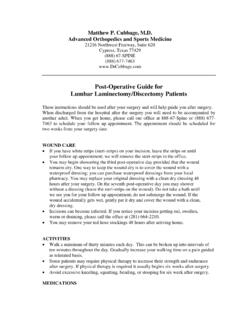Transcription of Post-Op Cervical Fusion - Spinal Surgeon
1 Advanced Orthopedics and Sports Medicine Post operative Spine Rehab- Cervical Fusion Treatment Guideline General Guidelines Decrease swelling Prevent stiffness/guarding Re-educate movement patterns/posture education Improve stabilization Increase activity tolerance Precautions Avoid extension with anterior Cervical Fusion Avoid flexion with posterior Cervical Fusion Promote AROM and avoid passive stretching Limit Cervical ROM until 8-10 weeks Phase I: Immediate post Surgical Phase (IPSP) 0-8 weeks Goals: 1. Decrease pain and inflammation. 2. Encourage wound healing. 3. Increase activity tolerance 4. Initiate aerobic activity 5. Monitor for signs of possible infection. 6. Educate on body mechanics and posture for bed mobility Precautions: 1.
2 Prevent excessive initial mobility or stress on tissues 2. Limit overhead arm movements, bending and lifting. 3. Please follow physician recommendations regarding use of collars etc. (multilevel fusions hard collar for 6 wks; one-level fusions wear a collar as needed for a week or two) Treatment Summary: 1. Education on bed mobility and transfers with proper spine positioning. 2. Reinforce basic Post-Op home exercise program including a. Diaphragmatic breathing b. Relaxation exercises c. Upper extremity extension isometric exercises 3. Increase tolerance to walking ( mile daily) or bike (15-30 min cardiovascular activity) 4. Reinforce sitting, standing and ADL modifications with neutral spine and proper body mechanics. Criteria for progression: 1.
3 Pain and swelling within tolerance. 2. Independent HEP 3. Tolerance of 15 min of exercise and 15-30 min of cardiovascular exercise. 4. Functional ADL for self care/hygiene Phase II: Initiation of OP-PT 8-12 weeks/2-3 times per week Goals: 1. Patient education/Back-Neck school 2. Reestablish neuromuscular recruitment of the longus colli (Functional dynamic stability) 3. Normalize scapulohumeral rhythm 4. Return to activities of daily living 5. Improve positional tolerances for return to work (sitting/standing 30-45 min) Precautions: 1. Avoid Cervical loading (overhead arm resisted movements) 2. Avoid passive stretching of Cervical spine Treatment Summary: Body Mechanics Education Anatomy, Pathology, & Biomechanics Reinforce neutral spine positioning Body mechanics and training: Performance of functional activities with neutral spine and protective positions Manual Therapy Grade 1 or grade 2 joint mobs for neuromodulation of pain Scar mobilization.
4 Educate patient in scar mobilization. Nerve mobilization (nerve glides). Do not reproduce symptoms. Exercises: Train upright posture. Diaphragmatic breathing: Proper breathing technique without the use of accessory respiratory muscles Initiate Cervical Isometric exercises. Initiate Cervical range of motion. Initiate Scapular movement re-education including shoulder shrugs, shoulder rolls, scapular mobilization exercises Upper thoracic mobilization exercises: cat/camel exercises, upper thoracic extension, upper thoracic rotation, arm clocks, combined thoracic/ Cervical motions Neuromuscular re-education of longus colli with pressure biofeedback (include arm and leg movements in varying positions) Restricted to 5 lbs with arm exercises (below 90 elevation) Abdominal Exercises (watch Cervical spine), perform basic core strengthening of lumbar spine.
5 (front and side planks) at 10-12 weeks Cardiovascular training, treadmill, UBE, stationary bike Address other mechanical restrictions as needed Modalities for symptom modulation if needed Criteria for progression: 1. Patient has working knowledge of body and lifting mechanics. 2. Able to hold chin tuck for 10 sec (raise of 10 mm Hg pressure from 20 mm HG baseline) 3. Cardiovascular tolerance to 30 min/day 4. Dynamic sitting and standing tolerance of 45-60 min Phase III: Advanced PT 12-18 weeks/2-3 times per week Goals: 1. Progress with strengthening and flexibility exercises. 2. Advanced lifting and posture training 3. Initiate balance activities 4. Address return to work/recreational activity concerns 5. Advanced stabilization and trunk control Treatment Summary: Body mechanics training Posture emphasis with exercises, posture training Work/activity specific training Manual Therapy Soft tissue mobilization to decrease guarding Joint mobilizations over restricted joints (around Fusion ) to increase contribution to overall movement (OA/AA and upper thoracic).
6 Protect Fusion . Nerve mobilization (nerve glides). Do not reproduce symptoms. Exercises: Train upright posture. Cervical mobility exercises (AROM is patient/physician/surgery dependent. Do not promote passive stretching). Occulomotor training and proprioceptive training (laser pointer) Upper extremity strengthening (Rhythmic stabilization upper extremity, free weight shoulder strengthening) Scapular stabilization/strengthening exercises (shoulder shrugs/rolls, prone scapular series) Spinal stabilization exercises lumbar and Cervical Continue Upper thoracic mobilization exercises Advanced balance training exercises. Neuromuscular re-education of longus colli with pressure biofeedback (include arm and leg movements in varying positions) Cardiovascular training, treadmill, UBE, stationary bike 14-18 weeks: Initiate advanced strengthening (chest press, seated rows, pull downs, incline push ups) and functional core strengthening (overhead chops, lifts, diagonal lifts, push ups).
7 Consider FCE. Criteria for discharge: 1. Manual muscle testing is within functional limits 2. Independent with home program 3. Cervical ROM within functional limits Pearls of rehab: Focus on local muscle systems (tonic/postural/stabilizing) longus colli before global (phasic/primary movers) such as SCM, PCM. Local muscles are shorter in length and closer to axis or rotation while the global muscles have no direct attachment on the spine. Avoid preloading the spine with overhead arm movements too early in rehab. Cervical range of motion and isometrics to start only after 8 weeks. No-pain no gain axiom usually does not apply to the spine Focus on low load high repetitions to improve endurance rather than high load low repetition for strength.
8 Focus on pain relief with Neck Disability Index of 50+, with scores of 30-50 focus on decreasing pain, muscle re-education, gradual strengthening, and flexibility and improve cardiovascular endurance, with scores less than 30 focus on work simulation and progressive strengthening.


